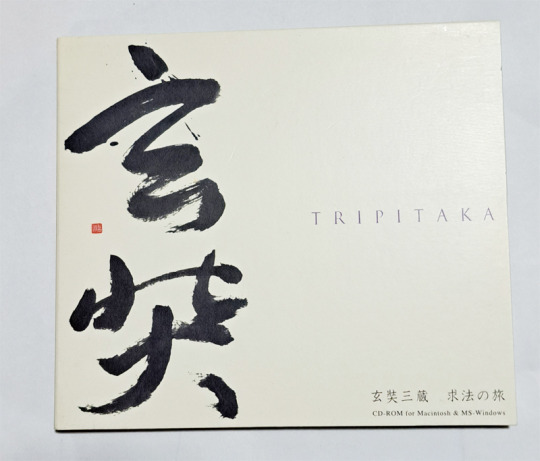#TRIPITAKA 玄奘三蔵求法の旅
Text
TRIPITAKA - the lost spiritual sequel to Cosmology of Kyoto was found

This post is a compilation of a series of tweets I have composed over a period of weeks during this summer.
For years, it was uncertain whether TRIPITAKA 玄奘三蔵求法の旅, by Soft Edge, had in fact ever been published. I remind the more absent-minded readers that this is the studio responsible for the mythical CD-ROM Cosmology of Kyoto, originally released in Japan in 1993, later published in the United States by Yano Electric in 1995. Knowledge of this their second and final production comes solely from the online CVs of producers Hiroshi Ōnishi and Mori Kōichi. No other information could be found online, and no actual copy of the game was known to exist.
Earlier this year, this disc surfaced at Yahoo Auctions. It sold for nearly $300 after 24 bids.

As suggested by its tile, which translates to Xuanzang Sanzo's Dharma-Seeking Journey, it was always assumed that the game illustrated episodes of the life of the celebrated Chinese Buddhist monk, particularly his 7th century pilgrimage to India. The captures printed on the back not only show a character highly reminiscent of the ancient scholar, they depict a variety of scenes taking place in China and India.
According to the severely incomplete archived version of PD Inc's website, the Japanese publisher responsible for this digipack, it was available for sale at museums hosting the 1999 Silk Road Journey To The West exhibition, which suitably matches the date printed on the back cover. However, this date presents yet another open question, as the Ōnishi-San and Kōichi-San bios both list it as a 1995 production.

The technical specifications may provide an enlightening clue, as they refer to Windows 95, 640x480px resolution and an 8-Bit color mode. This indicates that TRIPITAKA was indeed developed sometime between 1993 and 1995, although it was never published in the CD-ROM game circuit, certainly not in the immediate years after its development was completed. Combined with the data retrieved from the publisher's website, the edition shown here appears to have been produced solely for the occasion, as a means to diversify the museum shop catalog for this major exhibit, given the shared theme.
It would have been nearly impossible, had the program been in fact published in 1995, for a single copy to not have been spotted or mentioned online by the many Japanese collectors who have attempted to locate it for decades, unsuccessfully. On the other hand, a CD-ROM that was sold at a museum exhibit is likely to be purchased by visitors who were entirely unaware of the item's relevance as an elusive multimedia gem.
If a tangent is permitted here, both productions are inextricably linked with the museum space, and as far as I can speculate, Cosmology of Kyoto was, itself, also published with the intention of being made available in gallery stores in addition to computer game retailers. I say this because this was a production made possible by collaborative efforts including a variety of Japanese museums, to the extent these are referenced by name in the game's credits.
Considering the price at which the item was sold at auction, I was fairly certain that it was purchased by one such video game collector who knew exactly what they were bidding for. Later in July, I was able to locate the buyer and establish contact. Initially, the buyer was only able to produce this screenshot of the disc program launcher. The title reads "Cosmology of Asia", validating the claims that Soft Edge was in effect planning for series of edutainment software prior to its demise in the mid-90s.

In my second contact with the owner, I asked if he was available to produce a disc image and share it online for purposes of software preservation. The owner politely declined, stating that this was not something he was willing to do but offered to record the following gameplay video instead.
youtube
At a glance, the art style of Tripitaka is unsurprisingly similar to that of Cosmology. Most of its episodes occur during the day, whereas the latter was mostly played under the dark cover of night. The first scene depicts a dying Xuanzang reminiscing on his journeys in the company of a young chronicler. Structurally, both games are also nearly indistinguishable from one another, producing ample historical information for context, including detailed maps and chronologies.
TRIPITAKA was considered to be lost media for decades. As such, the importance of this footage could hardly be overstated. I would not hesitate to compare this development to the unearthing of Osamu Sato's Chu-Teng, the Eastern Mind sequel that was also deemed lost for many years, miraculously found during the time this blog was inactive.
I am delighted to have played a minor role in the unraveling of this thirty year old mystery, and can hardly contain my enthusiasm, as I now find myself equipped with sufficient information to produce a full post concerning a game about which I could not have written more than a sentence, just last year.
I would also like to thank the author of the @mendelpalace Tumblr for his timely alert regarding the Yahoo listing.
111 notes
·
View notes